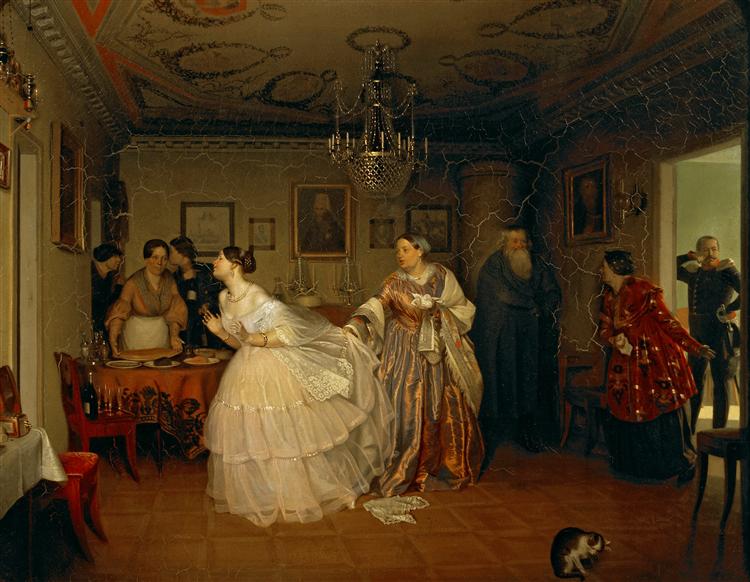Even before he wrote The Major’s Matchmaking, Fedotov composed a poetic foreword to the future picture: “Correction of circumstances, or the marriage of a major.” So the picture turned out to be like an illustration to this poem. And during an exhibition of his works in Moscow in 1850, he composed a long “race”, or an explanation of the painting “The Major’s Matchmaking”, which had a remark: “A common folk story, a lingering tune.” Fedotov himself loved to perform his race, imitating the intonations and dialect of a fairground barker-raeshnik inviting the audience to look through a peephole an amusing performance in pictures inside a box called a district committee:
Honest gentlemen, Come here! You are welcome, We are not asking for money: Look for nothing, Just wipe your glasses well. Begins, begins About how people in the world live, How others chew at someone else’s expense. They are too lazy to work, As they marry the rich.
It depicts the appearance of a major nobleman in a merchant’s house for a show, that is, the first acquaintance with a bride. Obviously, at the last moment, the bride realizes that in relation to this event she is too immodestly dressed, foolishly trusting a fashion magazine.
The compositional irony of this picture is that we see, unfolded, as on a stage, what is actually happening “on the threshold”, behind the scenes of the upcoming event: the major has not yet entered the hall. It is given to us to spy on what is happening “without witnesses” – there, in the hallway, and here, in the living room. Here is a commotion caused by the news of the arrival of the major. This message is brought by a matchmaker who crosses the threshold of the hall. There is a major, drawn in the doorway as he is drawn in front of the mirror in the hallway, twisting his mustache. His figure in the door frame here is the same as his figure in the mirror frame there, beyond the threshold. Fedotov wittily juxtaposes two scenes where the characters are still out of sight of each other. Therefore, it is easy to imagine a situation when a major enters a room, and the scene changes in the blink of an eye, the characters acquire decorous importance, put on masks of decency, and this will make everything fake.
Fedotov depicted a space opened by doors on either side, so that we see how the news of the Major’s arrival, like a draft, crosses the threshold of the door on the right and, picked up by a hanger sticking into the left door, goes on to walk through the inner chambers of the merchant house. In the very trajectory along which all the characters of the scene are built, the continuity is visually recreated, which is characteristic of a rather all-pervading sound. In this work, Fedotov achieves exceptional melodiousness, the “lengthiness” of the compositional rhythm, which is also stated in his race.
The inimitable eloquence of this picture is not the eloquence of an actual episode, as if copied from life (as in “The Discerning Bride”), but the eloquence of the artist himself, who acquired style, skill in storytelling, and the ability to transform into his heroes. A subtle measure of artistic convention is found here, associated with the laws of the scene, with a kind of stage affectation of poses, facial expressions, gestures. Thus, the depressing prosaism of the actual event is removed, it is transformed into a cheerful vaudeville rally.
In the linear score of the picture, the “vignette” motive varies. This rhythmic game includes the pattern on the tablecloth, and the decoration of the chandelier, and the zigzag strokes of the folds in the merchant’s dress, the small lace of the bride’s muslin dress, her fingers curved to the beat of the general pattern and the slightly mannered outline of the shoulders and head, amusingly reflected in the grace of the cat, ” washing “guests, as well as the silhouette of the major, the configuration of his posture, parodied in the curved legs of a chair at the right edge of the picture. With this play of lines bizarrely manifested in different incarnations, the artist ridiculed the pretentious ornamentation and variegation of the merchant’s house, and at the same time the heroes of the action. The author here is both a mocking composer of a comic situation and an applauding viewer who is pleased with the comedy he has performed. And he seems to be brushing over the painting anew in order to capture in it both his author’s irony and the spectator’s delight. This twofold essence of Fedotov’s pictorial “tale”, most fully manifested in The Major’s Matchmaking, is aptly defined in the response of one of his friends: “Your strength,” he noted, “is not in the teaching of morals, or, if you like, in only through the spectacle of the graceful. “
Let us emphasize that this spectacle of the graceful characterizes precisely the image of the author, his aesthetic position, his view of things. Fedotov’s precious painting is, as it were, a reflection of the artist’s joy, discovering beauty in the pictorial study of things and thereby conquering nature, which in reality does not always and most often do not predispose to admiration.
Year of painting: 1848.
Dimensions of the painting: 56 x 76 cm.
Material: canvas.
Writing technique: oil.
Genre: genre painting.
Style: realism.
Gallery: State Russian Museum, St. Petersburg, Russia.
